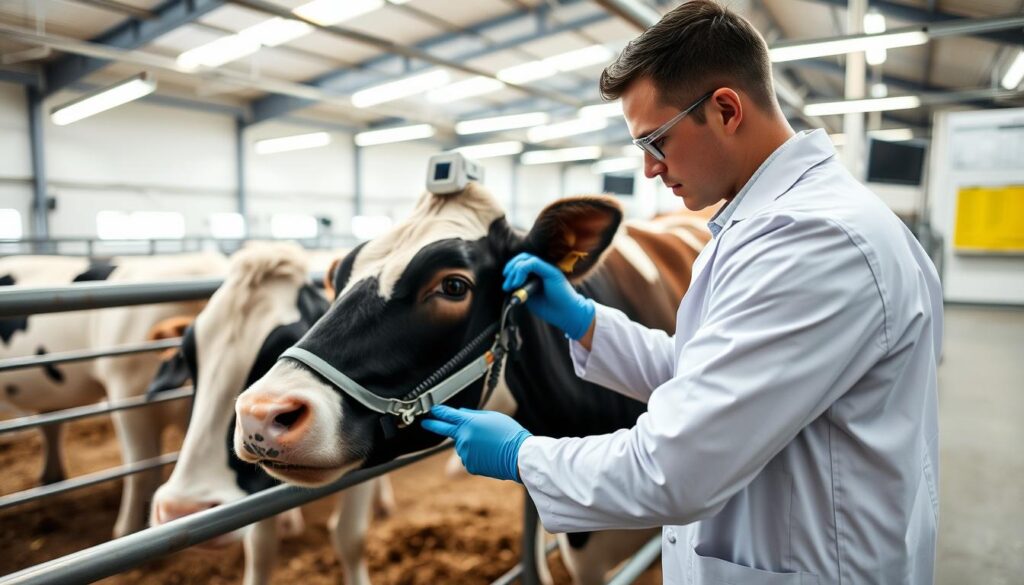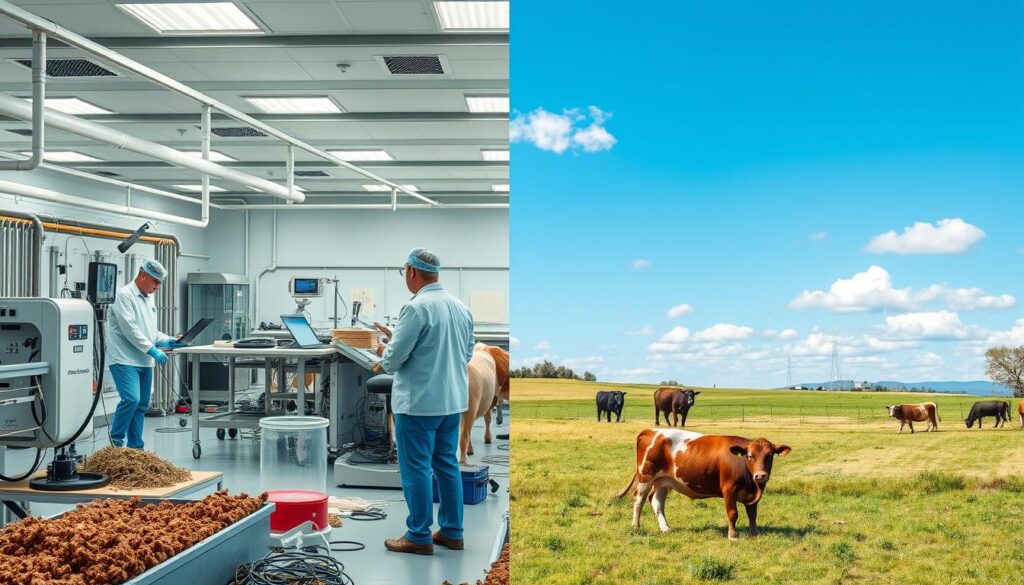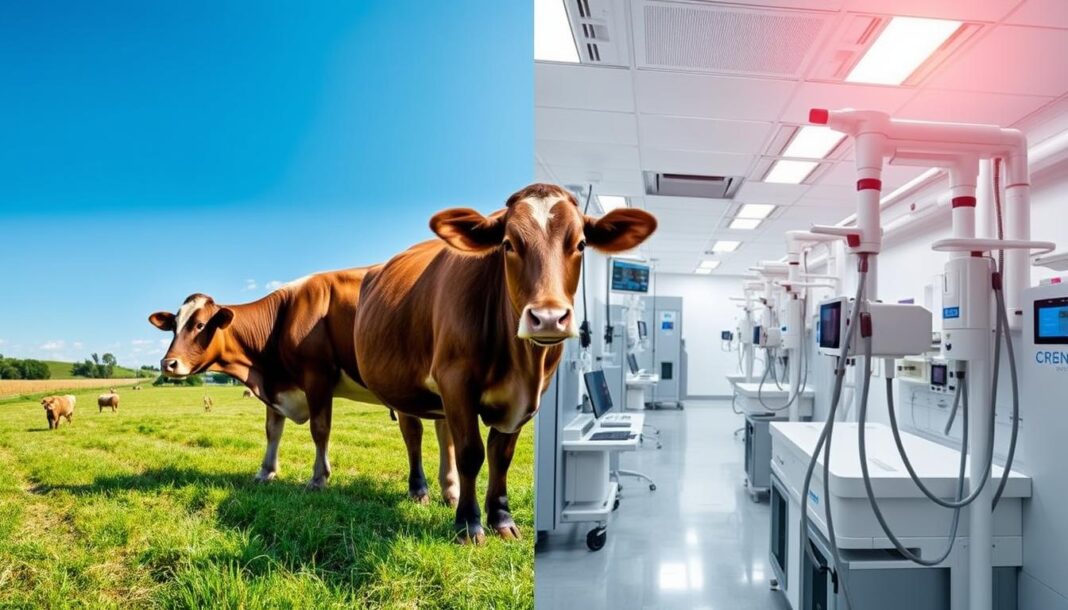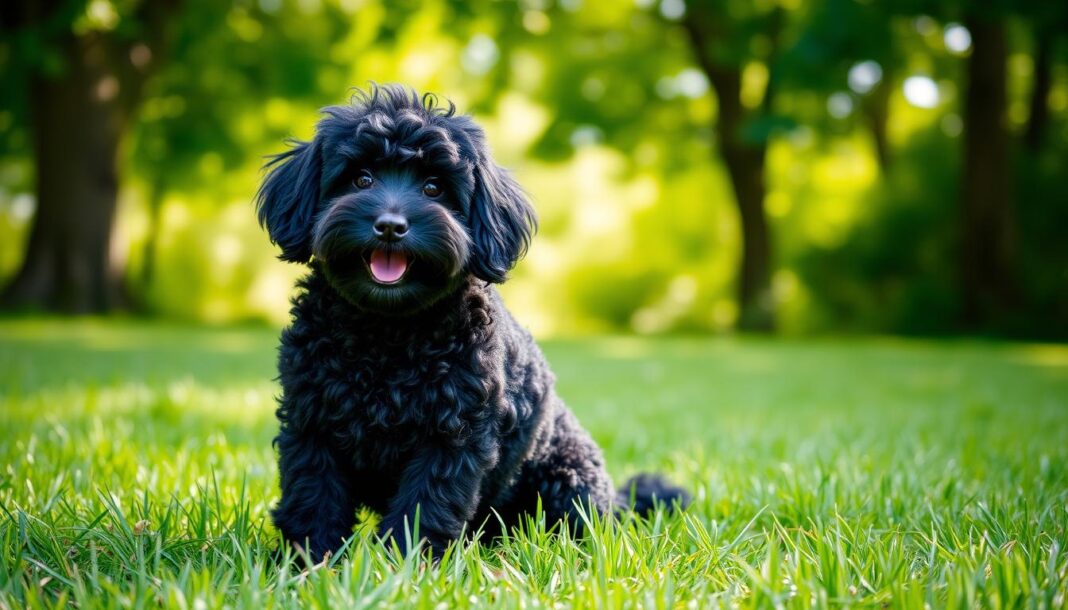AI vs Natural Breeding in Cattle
In 1998, a survey showed only 12% of U.S. beef producers used estrus synchronization. Less than 14% used artificial insemination (AI). This shows a big gap between U.S. farmers and others like Brazil, where AI use is much higher.
Choosing between artificial insemination and natural breeding is key. It affects your herd’s genetics, reproductive health, and productivity. We’ll look at the differences, benefits, and challenges of each method for sustainable farming.
Knowing the details of AI and natural breeding helps you make a smart choice. It fits your goals, resources, and future plans for your cattle. This guide is for both new and experienced farmers. It helps you understand cattle breeding better and improve your herd’s performance.
Introduction to Cattle Breeding Methods
Producers have two main ways to breed cattle: natural breeding and artificial insemination (AI). Natural breeding is the traditional way, where a bull mates with a group of cows. AI, on the other hand, uses genetically superior sires and precise breeding management.
Natural Breeding: An Overview
In natural breeding, producers pick healthy, fertile bulls. They also keep a bull-to-cow ratio of 20:1 to 30:1. Before breeding, bulls go through a breeding soundness exam to check if they can breed.
This method depends on the bull’s natural instinct to mate with cows.
Artificial Insemination: A Modern Approach
Artificial Insemination (AI) started in the early 1900s. It collects, processes, and stores semen from top bulls. Then, an AI technician inserts it into the female’s reproductive tract.
AI lets producers use more genetics and match each cow with the best sire. But, it needs special equipment, storage, and skilled people for success.
Both natural breeding and AI have their pros and cons. The choice depends on the producer’s goals, resources, and management. Success in breeding comes from good decisions, herd management, and focusing on reproductive factors.
Cost Comparison: Natural Breeding vs. Artificial Insemination
Choosing between natural breeding and artificial insemination (AI) affects your cattle operation’s costs and profits. Let’s explore the financial aspects of each method.
Natural breeding needs bulls, which cost around $2,500 for 5 years. Bulls also need feed and vet care, adding to costs. The feed price varies from $40.85 to $58.35 per head, based on the bull-to-cow ratio.
Vet expenses, like bull soundness exams and Ivormectin treatments, add to the natural breeding costs.
AI, on the other hand, has its own expenses. These include semen, synchronization, technician fees, and special equipment. The cost per head for AI ranges from $43.03 to $52.51, depending on conception rates.

AI might seem more expensive at first. But it can save money in the long run by improving genetics and reducing labor.
| Breeding Method | Cost Range |
|---|---|
| Natural Breeding | $40.85 – $58.35 per head |
| Artificial Insemination | $43.03 – $52.51 per head |
Research shows that a 30:1 bull-to-cow ratio is the most cost-effective for natural breeding. This can cost between $40.85 and $58.35 per head. AI costs vary with conception rates, with higher rates lowering costs.
Choosing between natural breeding and AI depends on your herd size, management, and goals. Natural breeding might be cheaper upfront. But AI can lead to better genetics, less labor, and higher profits over time.
Efficiency: Maximizing Semen Utilization
In cattle breeding, using semen efficiently is key for both natural breeding and AI. In natural breeding, a bull can produce more semen than needed, leading to semen wastage. To reduce this, the bull-to-cow ratio is important. A higher ratio, like 20:1 or 30:1, helps use the bull’s semen better.
Semen Wastage in Natural Breeding
In natural breeding, too much semen from a bull can be wasted. This problem can be solved by managing the bull-to-cow ratio well. A higher ratio, such as 20:1 or 30:1, helps use the bull’s semen more efficiently. This reduces wastage and boosts breeding efficiency.
Efficient Use of Semen in AI
Artificial Insemination (AI) is a better way to use semen. It involves diluting and extending a single ejaculate for multiple doses. This way, one high-quality semen sample from a superior bull can be used for many cows. This method maximizes the genetic benefits and improves semen efficiency in AI. It also allows cows in different places to be bred at the same time, making semen use even more efficient.

| Breeding Method | Semen Utilization | Potential Drawbacks |
|---|---|---|
| Natural Breeding | Potential for semen wastage due to excess production | Requires careful management of bull-to-cow ratio to minimize wastage |
| Artificial Insemination (AI) | Efficient use of semen through dilution and extension | Requires skilled technicians and careful planning to ensure successful breeding |
Understanding the differences in semen utilization in natural breeding and semen efficiency in AI helps cattle producers. They can make better choices to improve their breeding programs and reproductive success.
Genetic Selectivity and Variability
Artificial Insemination (AI) gives cattle breeders more control over genetics. They can pick from a few top sires to speed up genetic improvement. But, this method risks losing genetic diversity if not done right.
Controlling Inbreeding with AI
Natural breeding, on the other hand, keeps genetic diversity high. It helps avoid inbreeding depression, where bad traits become more common in related animals.
Risks of Poor Sire Selection in AI

The success of AI depends on choosing the right sires. If breeders don’t check the bulls’ genetics and health, bad traits can spread. This lowers diversity, makes animals more sick, and hurts performance. It’s key to look at the sire’s family history, breeding values, and looks to keep the herd healthy and productive.
Finding the right mix of genetic selectivity and diversity is key for AI users. By using AI wisely and keeping a diverse gene pool, breeders can make progress without the dangers of inbreeding and bad sire choices.
Flexibility in Handling Challenging Sires
Cattle breeding is complex, and dealing with aggressive sires is tricky. Artificial Insemination (AI) offers a solution. It makes your breeding program safer and more efficient, even with challenging bulls.
Natural breeding with big, unruly, or old bulls is risky. AI lets you use their genetics safely. This way, you avoid the dangers of natural mating.
AI is great when natural breeding is not safe or possible. It lets you add the good traits of tough bulls to your herd. This makes your cattle operations safer and more successful.
Using AI for challenging sires also boosts reproductive success. It ensures semen is used well and reduces waste. This leads to better conception rates and a more productive breeding season.
In short, AI’s flexibility in handling difficult bulls is a big advantage. It prioritizes safety and efficiency. This unlocks the value of these genetics while protecting your herd and staff. Your breeding program will be more successful and sustainable.
Risk Factors Associated with AI
Artificial insemination (AI) has changed cattle breeding a lot. But, it also brings risks that need careful handling. The success of AI depends a lot on the skill of the technician doing it.
Bad technique or dirty equipment can cause infections. This can hurt the chances of successful breeding.
Skilled Technicians and Sanitary Procedures
Good training, focus on details, and following clean protocols are key. The importance of AI technician skills is huge. They help keep things clean and reduce the risks of artificial insemination in cattle.
Timing and Planning Challenges
AI needs careful planning and timing. Cows must be perfectly synchronized for the best chance of fertilization. Things like finding heat, hormone use, and when the technician is available make AI hard.
It’s more work than natural breeding. Good herd management and planning are needed to beat these challenges.

Dealing with AI’s risks and challenges needs a deep understanding of the process. Focus on training, cleanliness, and planning helps. This way, dairy farmers can get the most out of AI and keep their herd healthy.
Ai vs Natural Breeding in Cattle
Choosing between artificial insemination (AI) and natural breeding in cattle involves looking at their pros and cons. AI lets you use top genetics, uses semen more efficiently, and gives you control over breeding. But, it needs special equipment, skilled people, and planning.
Natural breeding is easier and cheaper upfront but lacks genetic precision and can waste semen. The best choice for a cattle farm depends on herd size, management skills, budget, and breeding goals.
Advantages of Artificial Insemination (AI)

- Genetic Improvement: AI lets you use superior sires, speeding up genetic progress in your herd.
- Efficient Semen Utilization: AI lets one sire’s semen breed many females, cutting down on waste.
- Breeding Control: AI gives you more control over breeding, including timing for best fertility.
Advantages of Natural Breeding
- Lower Upfront Costs: Natural breeding needs less special equipment and labor, saving money upfront.
- Simplicity: It’s a simpler process, needing less planning and management than AI.
- Adaptability: Natural breeding works well for smaller herds or those with limited resources.
Choosing between AI and natural breeding for cattle is a big decision. It depends on each farm’s unique needs and situation. Weighing the good and bad of each method is key to the herd’s long-term success.
Reproductive Performance: AI vs Natural Service
Studies show that AI and natural breeding can have similar success rates in cattle. This is true if the AI program is well-managed and the bulls are of high fertility. The timing of insemination, semen quality, and herd health play big roles in both methods.
AI lets farmers choose the sire more precisely. But natural breeding might be better in some cases. For example, when dealing with hard-to-handle bulls or in herds with limited resources.
The type of sire can affect when a cow first calves. AI-sired cows might be a bit older at first calving than those from natural service bulls.
Pregnancy Outcomes
The U.S. dairy industry loses over $300 million each year because of estrus failure or misdiagnosis. A small increase in pregnancy rate can save between $22 and $35 per cow annually. The value of a new pregnancy is about $278, based on Holstein cow performance and U.S. prices.
Age at First Calving and Calving Interval
The sire type affects when a beef cow first calves. AI-sired cows tend to be a bit older than those from natural service bulls. But, the time between calvings is usually the same for both AI and natural service females, given the same nutrition and management.
Factors Influencing Reproductive Success
In cattle breeding, nutrition and the environment are key. They matter whether you’re using natural breeding or artificial insemination (AI). The right food and energy balance are vital for beef cattle’s reproductive health.
Nutrition and Energy Balance
Cows need enough energy, protein, vitamins, and minerals to breed well. Nutrition impacts on cattle reproduction are big. Without the right nutrients, cows may breed late, conceive less, and take longer to calve.
It’s important to meet the nutritional needs of the herd. This helps both AI and natural breeding systems work better.
Environmental Factors and Heat Stress
Environmental impacts on cattle breeding are also big. Heat stress can mess with breeding by upsetting hormones and body processes. Both AI and natural breeding can suffer from environmental stress.
Good housing, shade, and cooling are key. They help keep the herd healthy and reproductive efficiency up.
Knowing how nutrition and energy balance and environmental factors and heat stress affect breeding is important. Cattle producers can improve their breeding strategies. This boosts the reproductive success of their herds, no matter the breeding method.
Conclusion
Choosing between artificial insemination (AI) and natural breeding in cattle production is complex. AI can lead to genetic improvement and efficient semen use. It also offers flexibility in managing challenging sires. Yet, it needs specialized equipment and skilled technicians for success.
Natural breeding is simpler and cheaper upfront. It’s less labor-intensive. But, it lacks genetic selectivity and can lead to semen wastage.
The best breeding strategy depends on herd size, management, finances, and breeding goals. Understanding the summary of AI vs natural breeding in cattle helps make better decisions. This is key for improving your herd’s reproductive performance and productivity.
By weighing the pros and cons, you can pick the right method for your cattle operation. This choice is vital for increasing efficiency and profit.
Consider your specific needs and resources carefully. This way, you can choose a breeding method that fits your long-term goals. It will help your cattle operations succeed.




